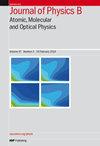Experimental study on rotational energy transfer in LiH (X1 ∑+ v) + Ar collisions
IF 1.5
4区 物理与天体物理
Q3 OPTICS
Journal of Physics B: Atomic, Molecular and Optical Physics
Pub Date : 2024-08-14
DOI:10.1088/1361-6455/ad6b67
引用次数: 0
Abstract
Using high-resolution transient laser spectroscopy, the rotational energy transfer between LiH (12, 8) and Ar through collisions was studied. LiH (12, 8) was generated via degenerate stimulated hyper-Raman scattering. The population of LiH (12,关于 LiH (X1 ∑+ v) + Ar 碰撞中旋转能量传递的实验研究
利用高分辨率瞬态激光光谱仪,研究了 LiH (12, 8) 和 Ar 之间通过碰撞产生的旋转能量转移。LiH (12, 8) 是通过变性受激超拉曼散射产生的。利用瞬态激光诱导荧光获得了碰撞过程中产生的 LiH(12,J″≠8)的数量。根据速率方程,在碰撞发生后 2 μs 内,从(12,8)态转移到(12,J″)态的速率系数介于 7.1 × 10-12 和 3.5 × 10-13 cm3 分子-1 s-1 之间。超过 2 μs 后,速率系数不再是常数。同时,在 10 μs 之前不会发生振动弛豫。旋转能 Erot 是各旋转态的旋转能之和(12,J″)。在 0-10 μs 期间,Erot 的值从 541 cm-1 下降到 390 cm-1。通过测量多普勒展宽线宽,可以得到 LiH (12, 8) 在不同延迟时间的平移能量 Etrans 分布情况。它从 0 μs 时的 707 cm-1 增加到 10 μs 时的 852 cm-1。因此,当发生旋转弛豫时,旋转能量的减少与平移能量的增加大致相等。
本文章由计算机程序翻译,如有差异,请以英文原文为准。
求助全文
约1分钟内获得全文
求助全文
来源期刊
CiteScore
3.60
自引率
6.20%
发文量
182
审稿时长
2.8 months
期刊介绍:
Published twice-monthly (24 issues per year), Journal of Physics B: Atomic, Molecular and Optical Physics covers the study of atoms, ions, molecules and clusters, and their structure and interactions with particles, photons or fields. The journal also publishes articles dealing with those aspects of spectroscopy, quantum optics and non-linear optics, laser physics, astrophysics, plasma physics, chemical physics, optical cooling and trapping and other investigations where the objects of study are the elementary atomic, ionic or molecular properties of processes.

 求助内容:
求助内容: 应助结果提醒方式:
应助结果提醒方式:


